Gariep at Orania from the restaurant.

The koeksuster statue is very well known. It is about as big as a person; I had expected it to be bigger. It is a piece of civic sculpture as is the pipe sculpture at the Cape Town Civic Centre. I like the concept, shape and execution. The village is enhanced by having it.
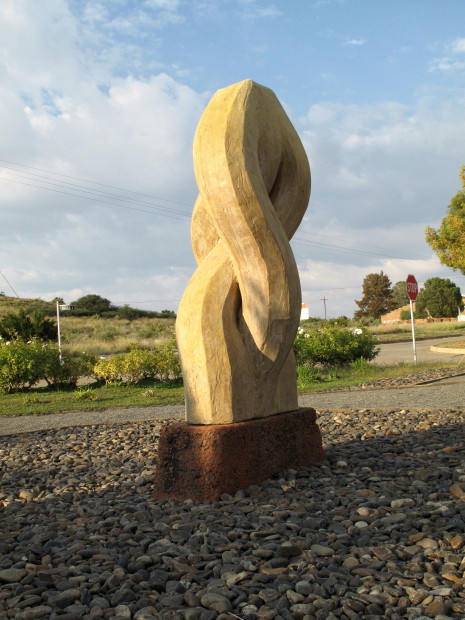
Edoardo Villa Sculpture Cape Town (only picture I could find on the web; those little dolls should not be on it).

It is called ‘The Knot’ not because it is meant to look like a knot but because it suggests a knot to some people (others say it ties the art at the Civic Centre together). Equally the ‘Koeksuster’ is a pleasing abstract shape which suggests a Koeksuster to some but the sculpture is not attempting to be a faithful copy of one.
I went straight to the campsite. It is still being built as part of a commercial complex down by the river that includes bungalows, restaurant and a hydro/gym. The receptionist was quite the opposite of what I expected. Instead of a surly, skinny, verkrampte person dressed in unflattering unfashionable clothing, no make-up or jewellery and scraggly hair I found a really good looking young woman at reception in fashionable and slightly revealing clothing. I asked her when she came to Orania; she and her brother had moved there from the Free State last year, he is an accountant. The buildings are all wood but not the usual unimaginative cluster of wendy houses. There is clearly an architect involved so the buildings and layout have style and it is modern. The campsite is expensive; R220 (WD thread said fully equipped chalet was R250 per head). Everything worked & there is a washing machine and fridge to use. The campsite was full by evening – mostly 4x4 & caravans.
It was about 16h30. There were 2 motocross (?) bikes in one of the chalet garages as the receptionist showed me to the campsite so I asked the guys there if I could change my engine oil as I like to do that every 2500km. Sure they said & told me where I could get oil before 5pm. Got the oil, back to their place, they lent me spanners (I had brought my special 6 sided socket for the Dakar instead of the one for the TW) & a cut open oil can. Cloth to clean my hands when finished & hand cleaner. Real nice guys (they were busy with a welding job).
This quote comes from William Dicey Borderline page 14:
Orania is odd. But not in the ways I thought it would be. For one, the Afrikaner volkstaat is no tradition-bound, Mormon-like community. It has one of the country's largest pecan orchards, and one of its most modern dairies. Anna Boshoff, Hendrik Verwoerd's daughter, is principal of the school. She had shown me around the day before, sad-eyed, businesslike, her hair pulled back in a bun. Pupils are given their work a week in advance. They do all their assignments on computer, a process their teacher monitors from a terminal. They don't wear uniforms and their hours of attendance are flexible. The school is, by anyone's standards, liberal. Which is not an adjective I was expecting to apply in Orania.
That’s not something I had expected in a reputedly conservative town. In fact that is extremely progressive. No uniforms – my children went to Michaeloak which has the same system.
From this WD thread I knew there is a straw bale house in Orania. They interest me so I was pleased to see this but it looks like a really sad straw bale house that has to have props to hold it together.
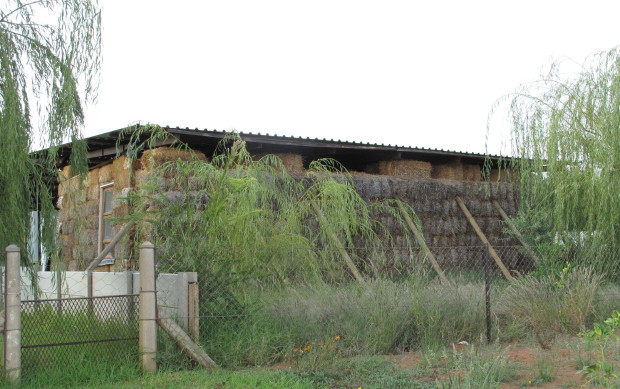
The owner/builder saw me & invited me in to have a look. In fact those poles are holding up an outer temporary wall which keeps the rain off the permanent wall until it gets plastered.

Inside it looks like this at present. The roof will have sisalation and ‘Think Pink’ insulation about 300mm thick. These houses are about low capital and running cost so heat insulation is primary, keep the heat out in summer and keep it in in winter.
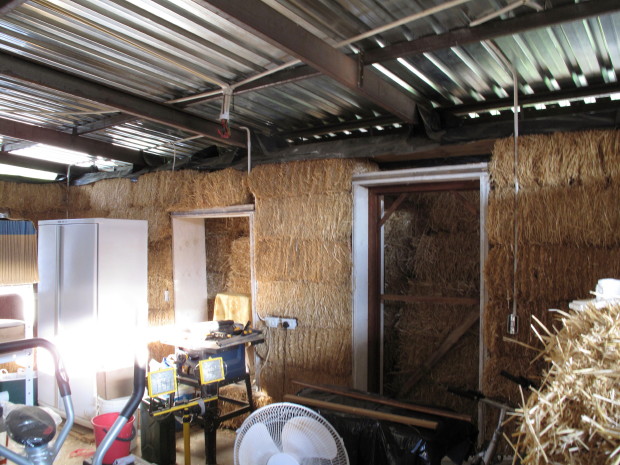
There are two parts to the house he is building. The roof of the front part rests directly on the straw bale walls so the walls are load bearing. He said it is a ball ache to build that way so the back part has steel columns to hold the roof up with the doors & windows attached to them. The straw bales are then simply slotted into place making it much easier to build.

The diagonal bracing is just temporary; they braced the whole roof structure before there were any windows and walls but they get removed when the straw bales are fitted. Look at the bottom of the un-filled section at the back. There are two 25mm (?) batterns on the concrete floor slab with aggregate (crushed stone) between. A layer of polyethylene dampcourse gets put on top of that under the first straw bale. If any water spills on the floor it can drain out under the straw bale without wetting the straw. I was told that termites have no interest in eating the straw.
Interestingly the owner appeared to be English speaking (it seemed to be his home language) and he does not currently live in Orania.
There are at least three other straw buildings in Orania. This jewellery shop.
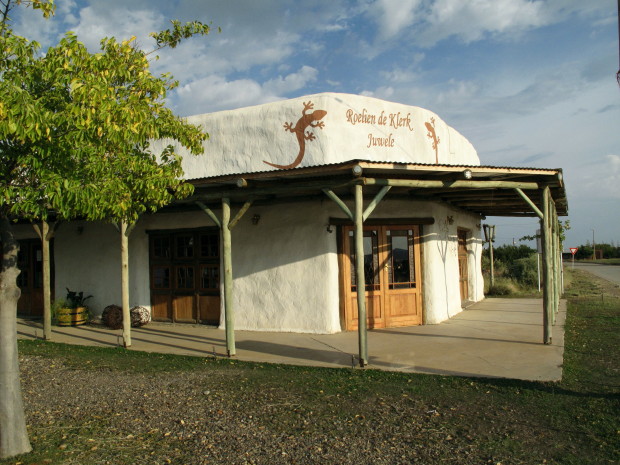
Roelien likes the soft rounded edges judging by how she has finished the back. I do too – a pleasant difference to the brutal hard & aggressive lines of modern houses like mine. This is much more organic and comfortable looking.

That is an evaporative cooler at the back. I have one at my house – brilliant things. Run it at night and you don’t wake up with a scratchy throat and burny eyes.
This double storey one which is quite conventional looking.
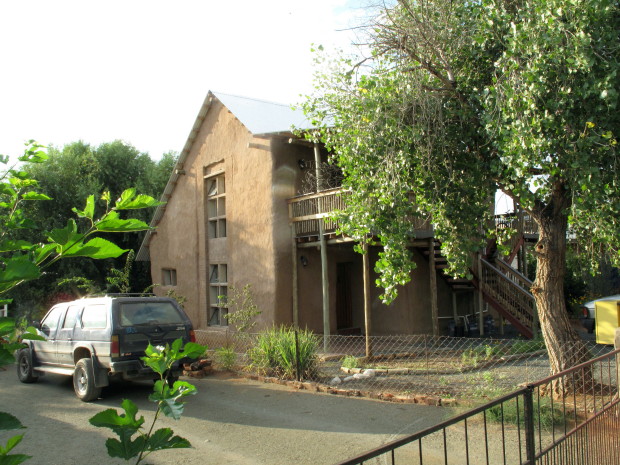
The fourth one is my favourite. Looks like a ginger bread house.

Not only do these houses insulate you well both in summer and winter but they must also be lovely and quiet inside. A really nice living space.
Here is the water supply to a house. Two pipes. The one with a filter is water straight out of the river for the garden, washing the car and stuff and flushing the loo. The insulated pipe is clean drinking water (its cold here at night in winter). Absolutely right. Supplying us with drinking water to flush down the toilet is extravagant in the extreme. I was really impressed in Mexico where all the drinking water is bought in 20 litre plastic bottles from the local osmosis plant. What is piped to the house is ok for cleaning; for cooking & food preparation you add a pill to it. Orania has chosen a slightly different system. Think of Port Elizabeth where they are building a desalination plant to supply water and lots of it is going to end up in the lavatory; if they had a water system like this or Mexico the desalination process need not be taken all the way to the drinking water stage.
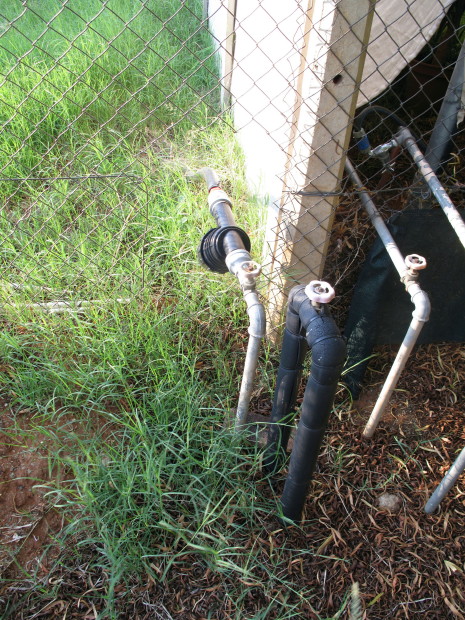
In Orania the residents have 4 dustbins & separate their rubbish. Quite novel for Africa but it is usual in the first world.

This is the hydro part of the commercial development where I camped. The west wall is very interesting. Made like a gabion but with smooth rounded stones as you see. In summer water flows down over the stones so the building has an entire wall as an evaporative cooler.
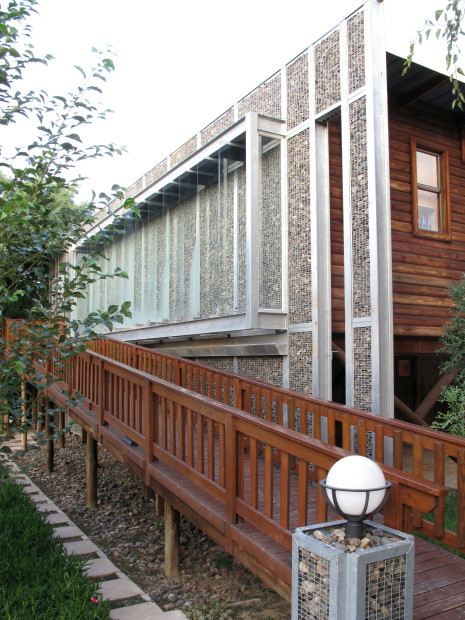
There are hinged glass louvers outside the gabion wall. In winter they close them so the afternoon sun shines through & heats the wall as if it was in a greenhouse or solar heater. At night the hot stones keep the inside cosy.
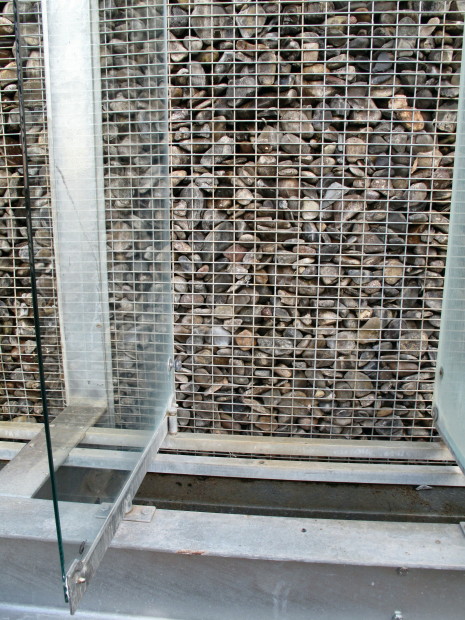
The hydro was closed so this picture has been taken through the glass north wall overlooking the Gariep so there are some reflections.
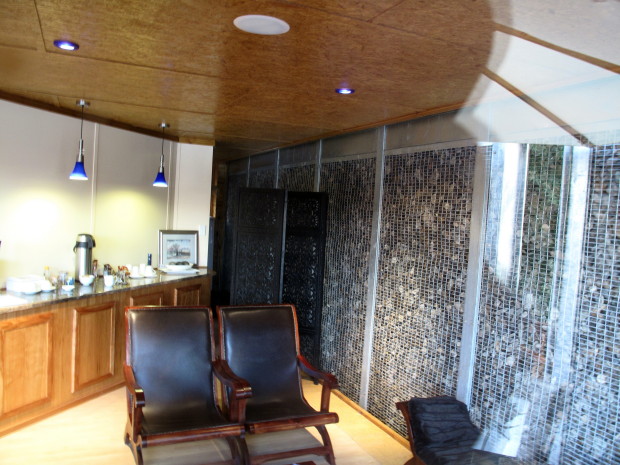


.
No comments:
Post a Comment